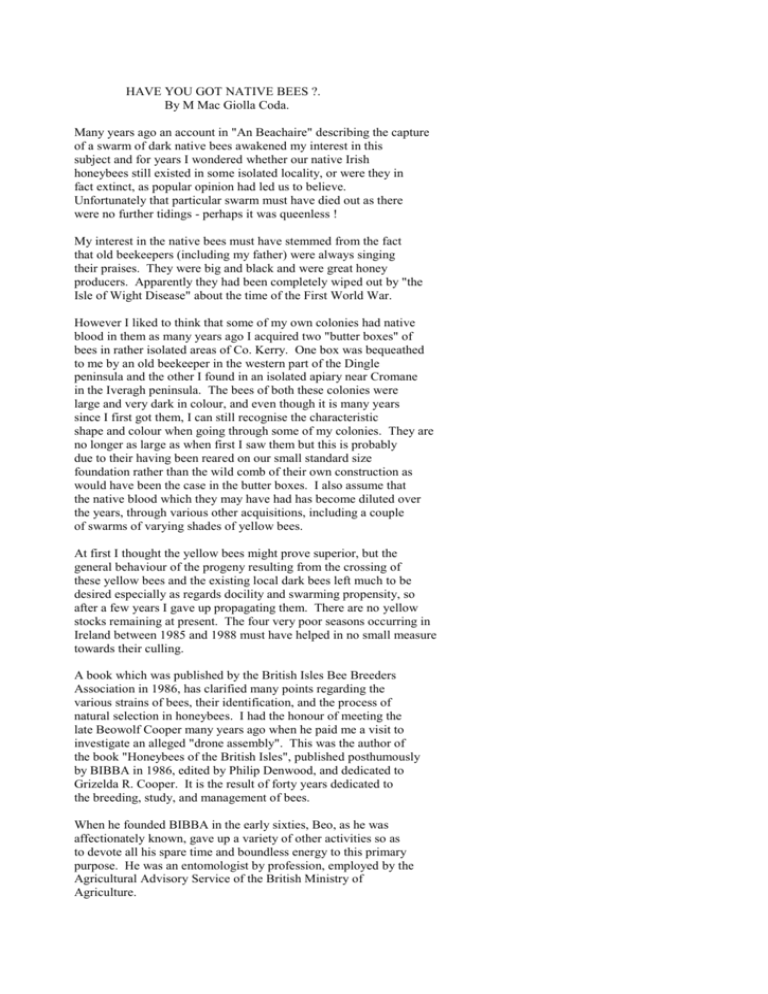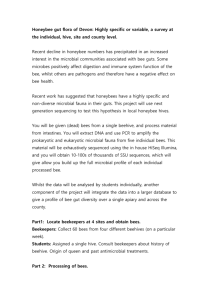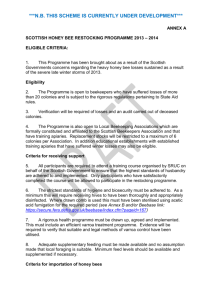Got Native Bees - South Tipperary Beekeepers Association
advertisement

HAVE YOU GOT NATIVE BEES ?. By M Mac Giolla Coda. Many years ago an account in "An Beachaire" describing the capture of a swarm of dark native bees awakened my interest in this subject and for years I wondered whether our native Irish honeybees still existed in some isolated locality, or were they in fact extinct, as popular opinion had led us to believe. Unfortunately that particular swarm must have died out as there were no further tidings - perhaps it was queenless ! My interest in the native bees must have stemmed from the fact that old beekeepers (including my father) were always singing their praises. They were big and black and were great honey producers. Apparently they had been completely wiped out by "the Isle of Wight Disease" about the time of the First World War. However I liked to think that some of my own colonies had native blood in them as many years ago I acquired two "butter boxes" of bees in rather isolated areas of Co. Kerry. One box was bequeathed to me by an old beekeeper in the western part of the Dingle peninsula and the other I found in an isolated apiary near Cromane in the Iveragh peninsula. The bees of both these colonies were large and very dark in colour, and even though it is many years since I first got them, I can still recognise the characteristic shape and colour when going through some of my colonies. They are no longer as large as when first I saw them but this is probably due to their having been reared on our small standard size foundation rather than the wild comb of their own construction as would have been the case in the butter boxes. I also assume that the native blood which they may have had has become diluted over the years, through various other acquisitions, including a couple of swarms of varying shades of yellow bees. At first I thought the yellow bees might prove superior, but the general behaviour of the progeny resulting from the crossing of these yellow bees and the existing local dark bees left much to be desired especially as regards docility and swarming propensity, so after a few years I gave up propagating them. There are no yellow stocks remaining at present. The four very poor seasons occurring in Ireland between 1985 and 1988 must have helped in no small measure towards their culling. A book which was published by the British Isles Bee Breeders Association in 1986, has clarified many points regarding the various strains of bees, their identification, and the process of natural selection in honeybees. I had the honour of meeting the late Beowolf Cooper many years ago when he paid me a visit to investigate an alleged "drone assembly". This was the author of the book "Honeybees of the British Isles", published posthumously by BIBBA in 1986, edited by Philip Denwood, and dedicated to Grizelda R. Cooper. It is the result of forty years dedicated to the breeding, study, and management of bees. When he founded BIBBA in the early sixties, Beo, as he was affectionately known, gave up a variety of other activities so as to devote all his spare time and boundless energy to this primary purpose. He was an entomologist by profession, employed by the Agricultural Advisory Service of the British Ministry of Agriculture. Not only did he carry out thousands of hive inspections in all parts of the Britain and Ireland, but he also travelled extensively abroad to study bee breeding techniques and native strains of bees especially in Belgium, France, Germany and South Africa. He gathered about him a dedicated band of beekeepers who were interested in breeding native bees, and through their collective enthusiasm BIBBA is a flourishing organization today. When he visited me Beo was accompanied by his wife Grizelda, who seemed to be equally imbued with enthusiasm for the work of preserving and propagating our native bee strains. Beekeeping in these islands suffered a great loss when Beowolf Cooper died in February 1982, and it was with great sadness that we learned of Grizelda's death in 1987. We have often heard and I am sure it is true that honeybees become acclimatized to the locality in which they live for some generations. Cooper in his book put forward the theories of isolation, both ecological and geographical and natural selection for having ensured the survival of native strains of bees despite the so called "Isle of Wight" epidemic and subsequent imports of foreign races and strains. He lists the following characteristics which favour the natural selection of native bees: Dark body colour. Low temperature working. Low temperature mating. High load carrying ability. Tolerance of wind. Minimum breeding out of season. Longevity. Supersedure. Resistance to certain diseases. These are the characteristics which assist in the preferential survival of our native bee strains in our island country which is situated on the edge of the natural range of the honeybee. Cooper offers a list of six groups of characters - comprising twenty-three individual characters, which are diagnostic of truly native bees. It is the combination of all or most of these characters together which makes a native British Isles bee. Most of these characters are behavioural and can be assessed during manipulations, etc. Four characters are physical which "aid survival in cool windy conditions in accordance with several well known general biological laws". These four characters are: 1. Colour - bees "black". 2. Long abdominal overhairs. 3. Characteristic wing type. 4. Genetically larger size. It is in assessing these characters that the technique of morphometry (formerly referred to as biometry) comes into force. When first I encountered the word "biometry", I developed an aversion to it. It was only when I read a couple of articles in the "Beekeepers Quarterly" that I began to understand the value of this facet of beekeeping. To further overcome my aversion I decided during winter of 1986-87 to try and put some of the theory into practice. I started by examining some samples of bees' wings to assess the discoidal shift and cubital index. I was surprised to find that the technique was quite simple, perhaps a bit tedious for the busy beekeeper in the height of the season, but as a winter occupation I found it both interesting and absorbing, and an ideal way to pass a long winter night. It is recommended to learn the technique of morphometry at a group session or workshop. If Irish readers are interested in taking part in one of these workshops I may be able to help out if they contact me. Information on the techniques of morphometric assessment and on the organisation of training workshops is also obtainable from the secretary of BIBBA. REFERENCES: Honeybees of the British Isles by Beowolf Cooper. The Beekeepers Quarterly No.8. February, 1987: " A Rational Approach to Bee Breeding" by John E. Dews. The Beekeepers Quarterly No. 9. May, 1987: "The Biometry of the Honeybee" by John E. Dews and Rev. E. Milner.






